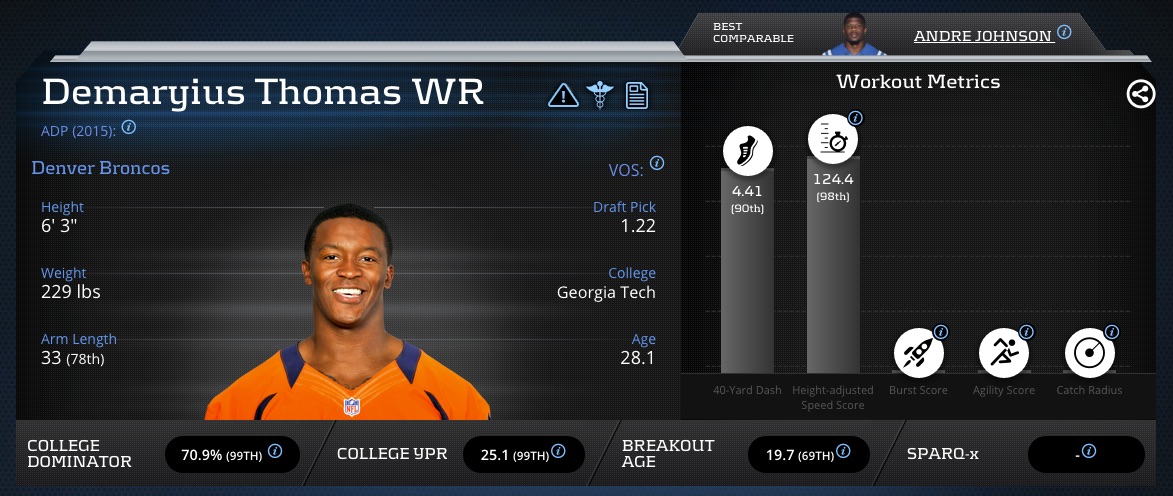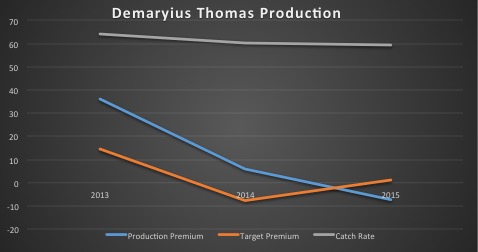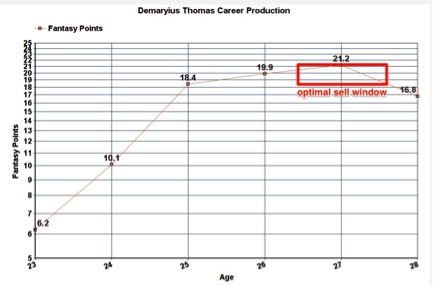Only winners get wings!
–Demaryius Thomas in a commercial for NFL.com fantasy football.
Over the last three years, Thomas has helped many fantasy football owners win league championships averaging 101-receptions, 1447-yards and 10-touchdowns per season. Thomas’ peaked in 2014 with 111-reception and 1619-yards. However, his ability to both eat wings and stay in the WR1 ranks is now a question mark.
Let’s look at Demaryius Thomas’ core profile before reviewing his year-over-year stats. Thomas suffered a foot injury in his final season at Georgia Tech and did not participate in most workouts. Before the foot injury, he ran a 4.41 (90th-percentile) 40-Yard Dash, which equates to a 124.4 (98th-percentile) Height-adjusted Speed Score (HaSS). Most impressively, Thomas was one of the most dominant wide receivers in college football history posting a 70.9-percent (99th-percentile) College Dominator Rating during his time at Georgia Tech. Wide receivers with Thomas’ combination of raw size and speed simply don’t come around often.

Demaryius Thomas Advanced Metrics Profile
Demaryius Thomas fully ascended to fantasy WR1 status in 2012 posting 94-receptions, 1434-yards, and 10-touchdowns. Thomas’ efficiency peaked in 2013 demonstrated by a +36.1 (No. 5) Production Premium (Production Premium measures a player’s productivity across league-average situations, discounting for things such as garbage time and 2-minute drill). Much of that production was in part due to a 61.9-percent (No. 10) Red Zone Catch Rank and 13 (No. 8) Red Zone Receptions, which led to a league-high 14-touchdowns. Though Thomas’ 64.3-percent catch rate was outside the top-30 in 2013, he dominated opposing defensive backs with 704 (No. 2) yards after the catch (YAC).
After a dominant 2013 season, Demaryius Thomas‘ 2014 ADP jumped into the first round (1.07, WR2). Why not? Thomas was enjoying enviable rapport with Peyton Manning who at the time was playing arguably the best football of his career. Tethered to a prolific Hall of Fame quarterback and gifted with a athletically dominant physical profile, Thomas seemed to destined for many more years as a fantasy WR1.
Demaryius Thomas finished 2014 with a career high 111-receptions and 1619-yards despite less plays per game (66.8). Thomas also continued his YAC monster ways finishing No. 2 in the league with 680-yards after the catch. However, the counting statistics don’t tell the full story. Thomas’ Production Premium dropped to +5.9 (No. 35) and his Target Premium dramatically declined to -7.7-percent (No. 68). Thomas closed out 2014 with 21.2-fantasy points per game, one of the most inefficient top-5 fantasy WR seasons of all time
Demaryius Thomas missed fantasy production expectations for the first time in his career last season when his fantasy output dropped from 21.2 to 16.8-fantasy points per game. Thomas’ underlying inefficiency finally affected his counting statistics. In 2015, he finished outside the top-50 in every meaningful wide receiver efficiency metric, from Production Premium to Target Premium to Yards Per Target. Though many fantasy owners were confronted with Thomas’ waning production for the first time in 2015, his effectiveness was quietly slipping for years.

Demaryius Thomas Peak Year Production (2013-2015)
Demaryius Thomas production dip can be partially blamed on poor play. Peyton Manning and Brock Osweiler finished 31st and 30th respectively in quarterback Production Premium last season. Past his prime, riding a mega-contract, and saddled with the worst QB play in the league, how can Thomas return to WR1 fantasy status? He can’t. Revealed as an inefficient wide receiver who was buoyed by a high-volume passing attack that was fueled by top-flight quarterback play, Demaryius Thomas’ dynasty stock crashed over the last six months as fantasy gamers quickly soured on him.

Demaryius Thomas Optimal Sell Window
Demaryius Thomas‘ dynasty stock declined so dramatically so fast, that many of his owners missed the optimal sell high window. Lacking the “Megatron mythology” of Calvin Johnson, Thomas has already become a toxic fantasy asset. Facing an utter valuation collapse, his dynasty owners only have bad choices. They must choose between desperately hoping for consistent WR2 production in 2016 (best case scenario) or accepting a fire sale offseason asking price. Ugh.


